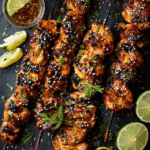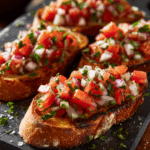The Salmon Rice Bowl is a TikTok-famous dish that has won hearts with its incredible flavor, simplicity, and customizability. Featuring flaked salmon, warm rice, creamy mayo, savory soy sauce, and the umami punch of seaweed and optional kimchi or avocado, this bowl is both comforting and energizing.
FULL RECIPE
Ingredients
- 1 cooked salmon fillet (grilled, baked, or pan-seared; approx. 120–150g)
- 1 cup hot cooked rice (white, brown, or jasmine)
- 1 tsp soy sauce (or tamari for gluten-free)
- 1 tsp sesame oil
- 1 tbsp Japanese mayo (or regular mayonnaise)
- ½ tsp sriracha (optional, for heat)
- ½ avocado, sliced (optional)
- 1 tsp furikake seasoning (optional)
- Pickled ginger or kimchi (optional)
- Roasted seaweed sheets or seaweed snacks (for wrapping or topping)
Directions
- Cook the Salmon:
Bake, grill, or pan-sear a salmon fillet until fully cooked and flaky. You can also use leftover salmon from a previous meal. - Flake the Salmon:
Place the cooked salmon in a bowl and flake it with a fork, removing any skin and bones. - Add Warm Rice:
Add a cup of freshly cooked rice over the flaked salmon. If using leftover rice, reheat it in the microwave with a splash of water to regain moisture. - Season and Mix:
Drizzle soy sauce and sesame oil over the rice and salmon. Add mayonnaise and sriracha (if using), then mix everything together until creamy and well combined. - Top and Customize:
Add toppings such as avocado slices, furikake, kimchi, or pickled ginger to enhance the flavor profile. - Serve with Seaweed:
Enjoy the bowl as-is, or scoop the mixture onto roasted seaweed sheets to eat like mini wraps.
Nutrition Facts
- Calories: 480 kcal
- Protein: 28 g
- Fat: 24 g
- Saturated Fat: 4 g
- Carbohydrates: 38 g
- Sugars: 2 g
- Fiber: 4 g
- Sodium: 780 mg
- Omega-3 Fatty Acids: ~1.5 g
- Cholesterol: 65 mg
Health Benefits of the Salmon Rice Bowl
One of the key reasons this dish has remained popular is its impressive nutritional profile. Salmon is a powerhouse of lean protein and is particularly rich in omega-3 fatty acids, which support heart, brain, and joint health. When paired with rice, the bowl offers a balanced ratio of protein to carbohydrates, providing sustained energy. Additional toppings like avocado contribute healthy fats, while fermented vegetables such as kimchi add gut-healthy probiotics. It’s a great example of a meal that’s both satisfying and nourishing, especially for those who prioritize a whole-food, balanced diet.
Ideal for Meal Prep and Busy Schedules
The Salmon Rice Bowl is a go-to for meal preppers and those juggling busy workweeks. Cooked salmon and rice can both be made in bulk and stored separately, allowing for easy daily assembly. Since most of the other components—mayo, sauces, toppings—are pantry or fridge staples, you can prepare a fresh-tasting bowl in under five minutes. It’s also flexible enough to accommodate what’s on hand, making it a practical solution for anyone needing quick lunches or no-fuss dinners without compromising on taste.
Customizations and Variations
Part of the charm of this bowl is how easy it is to customize. Different types of fish like tuna, mackerel, or even canned salmon can be used in place of cooked salmon. For a vegetarian option, swap the fish for grilled tofu or tempeh. You can adjust the flavor intensity by experimenting with sauces—try gochujang for heat, ponzu for a citrus kick, or peanut sauce for richness. Some versions include scrambled eggs, sautéed greens, or edamame for added nutrition. The bowl is essentially a blank canvas, open to endless flavor combinations and dietary adaptations.
Best Toppings to Elevate the Bowl
Toppings play a key role in enhancing both the flavor and texture of the Salmon Rice Bowl. Furikake—a Japanese seasoning made of seaweed, sesame seeds, and dried fish flakes—adds a salty, umami crunch. Avocado provides creamy contrast and healthy fats. Kimchi or pickled vegetables contribute tang and fermentation, making the meal more dynamic and gut-friendly. Chopped scallions, toasted sesame seeds, and chili crisp oil are also excellent options that layer in more flavor and visual appeal. Mixing and matching these toppings helps keep the meal exciting every time you make it.
Pairing Suggestions for a Complete Meal
While the bowl can stand alone, it also pairs wonderfully with a few side dishes or beverages to make a complete meal. A miso soup or a small bowl of wakame seaweed salad complements the flavors without overpowering them. For a drink, try green tea or a lightly sweetened iced jasmine tea, which helps cleanse the palate and enhance digestion. If you’re making the dish for dinner, a side of steamed or roasted vegetables like broccoli, snap peas, or mushrooms adds fiber and more nutritional depth.
Storage and Reheating Tips
Proper storage ensures that the bowl retains its flavor and texture for future meals. Cooked salmon should be stored in an airtight container in the fridge and consumed within 3 days. Rice should be cooled quickly and stored separately to avoid clumping. For best results, reheat rice with a splash of water and cover it when microwaving to restore its fluffiness. Salmon can be enjoyed cold or gently reheated in a pan or microwave. Keep sauces and toppings separate until you’re ready to eat to maintain the freshest textures.
Kid-Friendly and Family-Approved
The Salmon Rice Bowl is also an excellent option for families, including kids. Its soft textures, mild flavors, and colorful appearance make it appealing to younger eaters. You can make it more approachable by reducing spicy elements like sriracha and including kid-friendly toppings like grated cheese, corn kernels, or sliced cucumbers. Letting kids assemble their own bowls from pre-prepped ingredients is a fun and engaging way to get them involved in the kitchen and more excited about their meals.
Cultural Influence and Fusion Appeal
This dish draws strong influence from Japanese, Korean, and Hawaiian cuisine. The use of ingredients like soy sauce, sesame oil, seaweed, and furikake clearly shows its East Asian roots, while the bowl format is reminiscent of poke, a Hawaiian staple. The viral version blends these traditions into a contemporary fusion dish that appeals globally. It’s a great representation of how traditional ingredients and methods can be adapted to modern cooking habits without losing their cultural essence. The bowl celebrates culinary heritage while embracing innovation.
Budget-Friendly and Sustainable Cooking
Making a Salmon Rice Bowl doesn’t have to be expensive. While fresh salmon fillets are ideal, you can opt for canned salmon or even leftover grilled fish to reduce costs. Buying rice in bulk and using pantry staples like mayo, soy sauce, and sesame oil helps stretch your grocery budget. This dish also minimizes waste by allowing you to repurpose leftovers or use whatever vegetables are in your fridge. If you’re concerned about sustainability, choose wild-caught or responsibly farmed salmon and organic condiments when possible.
Advertisement
Conclusion
The Salmon Rice Bowl proves that delicious food doesn’t have to be complicated. With its blend of flavor, nutrition, convenience, and creativity, it’s no wonder the dish has gone viral and found a permanent place in kitchens around the world. Whether you’re seeking a fast lunch, a nutritious dinner, or a customizable family meal, this bowl delivers on every level. From cultural inspiration to modern-day meal prep needs, the Salmon Rice Bowl stands out as a flavorful and feel-good dish that’s here to stay.






